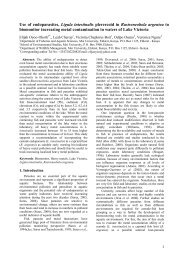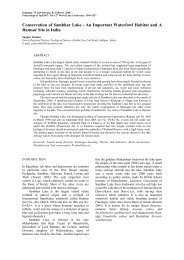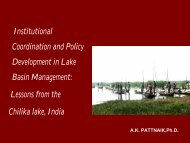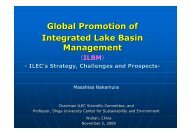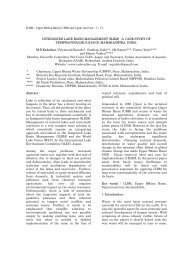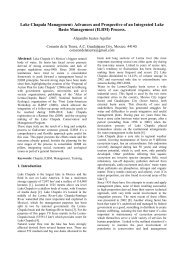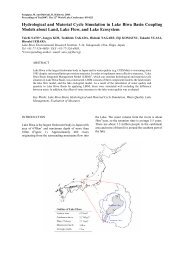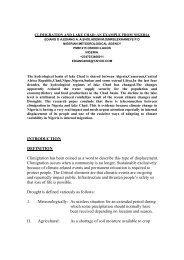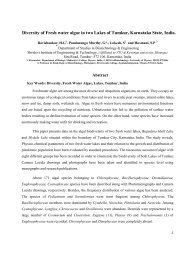Management of Haors, Baors, and Beels in Bangladesh Lessons for ...
Management of Haors, Baors, and Beels in Bangladesh Lessons for ...
Management of Haors, Baors, and Beels in Bangladesh Lessons for ...
You also want an ePaper? Increase the reach of your titles
YUMPU automatically turns print PDFs into web optimized ePapers that Google loves.
Protected lakes<br />
In <strong>Bangladesh</strong> few large lakes are protects under different<br />
Acts <strong>and</strong> treaties (Table 1).<br />
Ecologically Critical Area<br />
The Government <strong>of</strong> <strong>Bangladesh</strong> has notified 8 ecologically<br />
important areas as Ecologically Critical Areas on 1999 under<br />
the Environment Protection Act 1995. With this notification<br />
the Government has prohibited the follow<strong>in</strong>g activities:<br />
• Harvest<strong>in</strong>g any natural vegetation<br />
• All k<strong>in</strong>d <strong>of</strong> kill<strong>in</strong>g <strong>of</strong> wildlife<br />
• Collection <strong>of</strong> snail, coral, turtle or any wild animal<br />
• Any activities that can hamper the habitat <strong>of</strong> animals<br />
<strong>and</strong> plants<br />
• Any activities that can change the character <strong>of</strong> l<strong>and</strong> <strong>and</strong><br />
water<br />
• Establish<strong>in</strong>g any <strong>in</strong>dustry that can pollute soil, water<br />
<strong>and</strong>/or air<br />
• Any activities that can harm fish <strong>and</strong> aquatic animal<br />
Report Card<br />
Report card is a very simple, effective, participatory <strong>and</strong><br />
empower<strong>in</strong>g tool that can enable the community to establish<br />
a transparent <strong>and</strong> accountable participatory monitor<strong>in</strong>g<br />
system. All the pages <strong>of</strong> the Report Cards consists a<br />
lot <strong>of</strong> relevant pictures <strong>of</strong> the <strong>in</strong>dicators, which makes the<br />
Report Card a self-monitor<strong>in</strong>g tool that allows the community<br />
to monitor the processes <strong>of</strong> any development program<br />
or activities <strong>in</strong> their comm<strong>and</strong> area. In this process, pictures<br />
are used to underst<strong>and</strong> the activities <strong>of</strong> the respective<br />
stakeholders. These pictures are particularly helpful <strong>for</strong><br />
those people who cannot read or write. Through observ<strong>in</strong>g<br />
the pictures, they will underst<strong>and</strong> on which extent they<br />
have to score. The use <strong>and</strong> development <strong>of</strong> report <strong>for</strong> community<br />
based monitor<strong>in</strong>g <strong>and</strong> evaluation is described as<br />
Annex V (CNRS & ITAD).<br />
Table 1. Major Protected Lakes <strong>of</strong> <strong>Bangladesh</strong><br />
Sl Lake Protected Under<br />
1 Tangua Haor Ramsar<br />
2 Ram Sagar National Park<br />
3 Hakaluki Haor Ecologically Critical Area<br />
4 Gulshan Lake Ecologically Critical Area<br />
5 Marjut Baor Ecologically Critical Area<br />
6 Bikka beel Fish Sanctuary<br />
<strong>Lessons</strong> <strong>for</strong> Lake Bas<strong>in</strong> <strong>Management</strong><br />
<strong>Lessons</strong> <strong>for</strong> Lake Bas<strong>in</strong> management<br />
In <strong>Bangladesh</strong> the natural resources <strong>of</strong> the wetl<strong>and</strong>s are the<br />
ma<strong>in</strong> livelihood options <strong>for</strong> the people. The problems from<br />
<strong>in</strong>dustrial pollution are not that major. A number <strong>of</strong> projects<br />
<strong>and</strong> tools have been discussed <strong>and</strong> those tools were successfully<br />
implemented <strong>in</strong> a large lake bas<strong>in</strong>. Consider<strong>in</strong>g<br />
the need <strong>and</strong> management contests the experiences from<br />
successful projects <strong>and</strong> the tools can be dissem<strong>in</strong>ated <strong>in</strong> the<br />
lake bas<strong>in</strong>. For the susta<strong>in</strong>ability potential consideration <strong>of</strong><br />
<strong>in</strong>tuitional arrangement is necessary.<br />
Institutional Arrangement <strong>for</strong> Susta<strong>in</strong>able Resource<br />
<strong>Management</strong><br />
Eco-specific participatory natural resource management<br />
<strong>and</strong> human well be<strong>in</strong>g <strong>in</strong>volves enabl<strong>in</strong>g the local community<br />
actors <strong>and</strong> <strong>in</strong>stitutions to build relevant capacity to<br />
participate <strong>in</strong>:<br />
• Identify<strong>in</strong>g <strong>and</strong> prioritiz<strong>in</strong>g problems <strong>and</strong> concerns with<br />
regard to susta<strong>in</strong>able natural resource management;<br />
• Build<strong>in</strong>g consensus with<strong>in</strong> <strong>and</strong> across stakeholders<br />
with conflict<strong>in</strong>g <strong>in</strong>terests <strong>and</strong> concerns;<br />
• Identify<strong>in</strong>g <strong>and</strong> select<strong>in</strong>g options <strong>and</strong> resources to<br />
address the concerns <strong>and</strong> <strong>in</strong>terests;<br />
• Develop<strong>in</strong>g action plans <strong>and</strong> secure commitments <strong>for</strong><br />
responsibility shar<strong>in</strong>g;<br />
• Manag<strong>in</strong>g <strong>and</strong> monitor implementation if the plan,<br />
<strong>and</strong><br />
• Review<strong>in</strong>g if results, outcomes <strong>of</strong> implementation <strong>and</strong><br />
cont<strong>in</strong>ue participatory plann<strong>in</strong>g <strong>and</strong> management<br />
cycle.<br />
Objectives, key issues, problems <strong>and</strong> <strong>in</strong>terventions <strong>for</strong> ecospecific<br />
participatory natural resource management were<br />
synthesized by Rahman et. al. 2003 from number <strong>of</strong> practices<br />
<strong>in</strong> <strong>Bangladesh</strong> (Table 2).<br />
In design<strong>in</strong>g <strong>in</strong>terventions <strong>for</strong> management <strong>of</strong> a lake bas<strong>in</strong><br />
a review on the above mention table could be supportive.<br />
Establish<strong>in</strong>g participatory natural resource management<br />
<strong>in</strong>volves a process <strong>of</strong> learn<strong>in</strong>g by do<strong>in</strong>g, <strong>and</strong> very actively<br />
yields some valuable results <strong>and</strong> experience, not only <strong>for</strong><br />
the participat<strong>in</strong>g stakeholders but also <strong>for</strong> the facilitat<strong>in</strong>g<br />
actors <strong>and</strong> <strong>in</strong>stitutions.<br />
Key considerations <strong>in</strong> eco-specific participatory natural<br />
resource management are presented below:<br />
• Involve as many relevant government agencies <strong>and</strong><br />
departments, NGOs <strong>and</strong> community organizations <strong>in</strong><br />
the process as early a possible<br />
7



